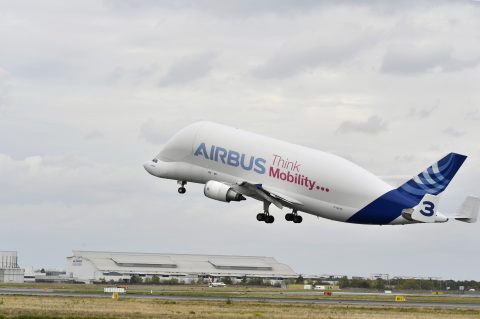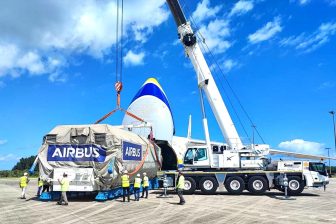
Airbus BelugaST flies Eutelsat satellite to Kennedy Space Center
Airbus’ giant of the skies, BelugaST (A300-600ST) has made its first trip over the pond since 2009, bringing the Airbus-built HOTBIRD 13G satellite for Eutelsat to the Kennedy Space Center at Cape Canaveral, Florida.
The delivery was completed only hours after the satellite’s twin, the HOTBIRD 13F was launched by a SpaceX Falcon 9 rocket. For this mission, years after the Beluga aircraft transporter the International Space Station European module Tranquility, the aircraft used 30 percent Sustainable Aviation Fuel (SAF) for its departure flight from Toulouse – reflecting Airbus’ decarbonisation ambitions.
The spacecraft are the first members of the new “Eurostar Neo” family of Airbus telecommunications satellites, based on a next-generation platform and technologies developed with the support of the European Space Agency (ESA), and others, including the Centre National d’Etudes Spatiales (CNES) and the UK Space Agency (UKSA).
“It is a true honour to consecutively showcase two satellites for our customer Eutelsat: two pieces of European technology at the iconic Kennedy Space Center,” said Jean-Marc Nasr, Head of Space Systems at Airbus. “The ability of Airbus to field an autonomous European solution is underscored by the transportation of our satellites in the unique Beluga aircraft – a true example of pan-Airbus synergies!”
Once they reach their orbital position, these two satellites, with more efficient power and thermal control systems than their predecessors, will be able to broadcast more than 1,000 television channels across Europe, Northern Africa and the Middle East. They will also enhance Eutelsat’s ability to provide connectivity for more than 135 million people, as they replace three Eutelsat satellites currently in orbit.
With the advent of the new BelugaXL, based on the larger A330-200 platform, the existing BelugaST fleet is progressively being made available for outsized freight transport services globally. Since the launch of the new Airbus Beluga Transport service in January, the BelugaST has performed missions for various customers worldwide.



